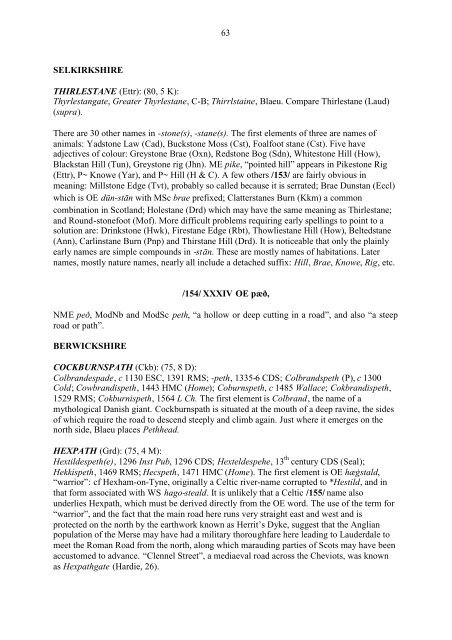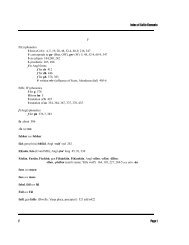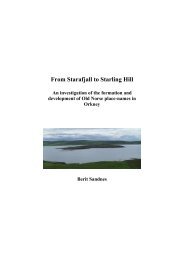May Williamson: The Non-Celtic Place-Names of the Scottish Border ...
May Williamson: The Non-Celtic Place-Names of the Scottish Border ...
May Williamson: The Non-Celtic Place-Names of the Scottish Border ...
You also want an ePaper? Increase the reach of your titles
YUMPU automatically turns print PDFs into web optimized ePapers that Google loves.
63<br />
SELKIRKSHIRE<br />
THIRLESTANE (Ettr): (80, 5 K):<br />
Thyrlestangate, Greater Thyrlestane, C-B; Thirrlstaine, Blaeu. Compare Thirlestane (Laud)<br />
(supra).<br />
<strong>The</strong>re are 30 o<strong>the</strong>r names in -stone(s), -stane(s). <strong>The</strong> first elements <strong>of</strong> three are names <strong>of</strong><br />
animals: Yadstone Law (Cad), Buckstone Moss (Cst), Foalfoot stane (Cst). Five have<br />
adjectives <strong>of</strong> colour: Greystone Brae (Oxn), Redstone Bog (Sdn), Whitestone Hill (How),<br />
Blackstan Hill (Tun), Greystone rig (Jhn). ME pike, “pointed hill” appears in Pikestone Rig<br />
(Ettr), P~ Knowe (Yar), and P~ Hill (H & C). A few o<strong>the</strong>rs /153/ are fairly obvious in<br />
meaning: Millstone Edge (Tvt), probably so called because it is serrated; Brae Dunstan (Eccl)<br />
which is OE dn-stān with MSc brae prefixed; Clatterstanes Burn (Kkm) a common<br />
combination in Scotland; Holestane (Drd) which may have <strong>the</strong> same meaning as Thirlestane;<br />
and Round-stonefoot (M<strong>of</strong>). More difficult problems requiring early spellings to point to a<br />
solution are: Drinkstone (Hwk), Firestane Edge (Rbt), Thowliestane Hill (How), Beltedstane<br />
(Ann), Carlinstane Burn (Pnp) and Thirstane Hill (Drd). It is noticeable that only <strong>the</strong> plainly<br />
early names are simple compounds in -stān. <strong>The</strong>se are mostly names <strong>of</strong> habitations. Later<br />
names, mostly nature names, nearly all include a detached suffix: Hill, Brae, Knowe, Rig, etc.<br />
/154/ XXXIV OE pæð,<br />
NME peð, ModNb and ModSc peth, “a hollow or deep cutting in a road”, and also “a steep<br />
road or path”.<br />
BERWICKSHIRE<br />
COCKBURNSPATH (Ckb): (75, 8 D):<br />
Colbrandespade, c 1130 ESC, 1391 RMS; -peth, 1335-6 CDS; Colbrandspeth (P), c 1300<br />
Cold; Cowbrandispeth, 1443 HMC (Home); Coburnspeth, c 1485 Wallace; Cokbrandispeth,<br />
1529 RMS; Cokburnispeth, 1564 L Ch. <strong>The</strong> first element is Colbrand, <strong>the</strong> name <strong>of</strong> a<br />
mythological Danish giant. Cockburnspath is situated at <strong>the</strong> mouth <strong>of</strong> a deep ravine, <strong>the</strong> sides<br />
<strong>of</strong> which require <strong>the</strong> road to descend steeply and climb again. Just where it emerges on <strong>the</strong><br />
north side, Blaeu places Pethhead.<br />
HEXPATH (Grd): (75, 4 M):<br />
Hextildespeth(e), 1296 Inst Pub, 1296 CDS; Hexteldespehe, 13 th century CDS (Seal);<br />
Hekkispeth, 1469 RMS; Hecspeth, 1471 HMC (Home). <strong>The</strong> first element is OE hæġstald,<br />
“warrior”: cf Hexham-on-Tyne, originally a <strong>Celtic</strong> river-name corrupted to *Hestild, and in<br />
that form associated with WS hago-steald. It is unlikely that a <strong>Celtic</strong> /155/ name also<br />
underlies Hexpath, which must be derived directly from <strong>the</strong> OE word. <strong>The</strong> use <strong>of</strong> <strong>the</strong> term for<br />
“warrior”, and <strong>the</strong> fact that <strong>the</strong> main road here runs very straight east and west and is<br />
protected on <strong>the</strong> north by <strong>the</strong> earthwork known as Herrit’s Dyke, suggest that <strong>the</strong> Anglian<br />
population <strong>of</strong> <strong>the</strong> Merse may have had a military thoroughfare here leading to Lauderdale to<br />
meet <strong>the</strong> Roman Road from <strong>the</strong> north, along which marauding parties <strong>of</strong> Scots may have been<br />
accustomed to advance. “Clennel Street”, a mediaeval road across <strong>the</strong> Cheviots, was known<br />
as Hexpathgate (Hardie, 26).




